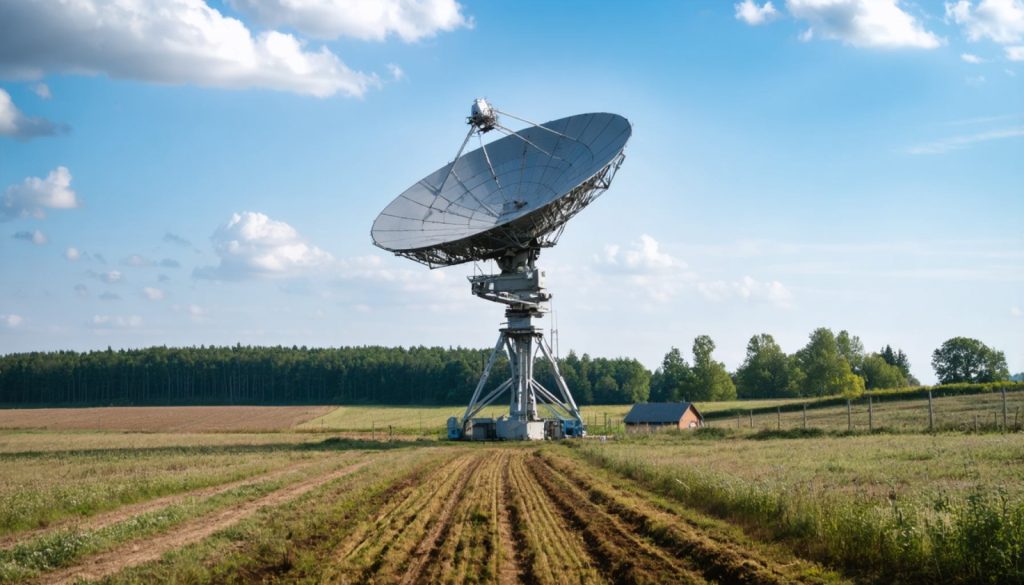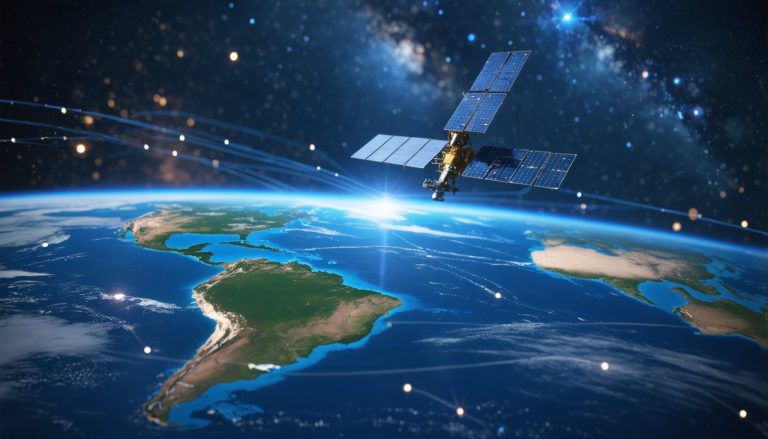
- Satellite broadband revolutionizes internet access in remote areas, bypassing physical infrastructure and enhancing connectivity.
- It offers speeds comparable to traditional broadband, enabling rural regions to access educational, economic, and healthcare resources.
- Empowers communities for global participation in e-commerce, remote work, and digital marketing, bridging the digital divide.
- Facilitates telemedicine, helps farmers with data access, and connects students with educational resources.
- Though challenging to implement, satellite technology holds great promise for digital inclusivity worldwide.
Picture yourself standing in a serene, rural setting. Rolling hills stretch as far as the eye can see, bathed in the golden hues of the late afternoon sun. Silence pervades the air, interrupted only by the distant rustle of leaves and chirping of birds. But beneath this calm exterior lies a challenge that many of these idyllic regions face: lagging connectivity and lack of access to digital resources.
Enter satellite broadband, a pioneering technology poised to revolutionize internet access in remote areas. It acts as a lifeline, reaching places where traditional broadband providers cannot. Imagine a gleaming satellite hovering miles above the Earth, beaming internet signals directly down to rooftops where ordinary wires struggle to reach. This is not just the stuff of science fiction. It is the new frontier of providing global connectivity.
What Makes Satellite Broadband Stand Out?
Benefit from the vast expanse of the sky instead of relying on physical cables. Satellite broadband bypasses the structural challenges of remote topography. Unlike fiber-optic cables that snake through landscapes, requiring extensive and costly infrastructure, satellites dispense their services from above, blanketing entire regions with a web of digital connectivity.
Every rustic village or picturesque farmhouse can tap into the kind of internet access that was once exclusive to urban centers. Reaching speeds equivalent to or even exceeding those of ground-based broadband, satellite internet connects the unconnected, fostering educational opportunities, boosting local economies, and unveiling a world of information previously out of reach.
The Real-World Impact
Consider how telemedicine, for instance, transforms healthcare access. Rural doctors use video consultations to link patients with specialists many miles away. Farmers access real-time weather forecasts and market trends, optimizing their productivity and sustainability. Students in once-isolated towns now have insight into the vast goldmine of online educational resources.
Furthermore, satellite broadband empowers these communities to compete on a global scale, taking part in e-commerce, remote work, and digital marketing. This is a game-changer in an economy that increasingly values access over geography.
The Clear Takeaway
While the challenges of implementing and maintaining satellite technology are non-trivial, its potential to bridge the digital divide is immense. Satellite broadband serves as a critical tool in global digital inclusivity. For those in underserved areas, the skies above hold the promise of unprecedented connectivity, ensuring that the digital divide continues to narrow, and no corner of our world remains in the shadow of digital darkness.
So, next time you gaze at the night sky, remember the invisible threads of communication weaving through the constellations, bringing us all a little closer together in the vast expanse of digital opportunity.
The Revolution of Satellite Broadband: Connecting the Unconnected
A Deeper Dive into Satellite Broadband Technology
The advent of satellite broadband technology has indeed opened the gates to unprecedented connectivity for remote areas. However, there is more to explore about its infrastructure, possibilities, and limitations.
How Satellite Broadband Works
Satellite broadband relies on three main components:
1. Satellite Dish: Installed at the user’s location, this dish sends and receives signals to and from the orbiting satellite.
2. Satellite: Positioned in geostationary or low Earth orbit, the satellite acts as a relay station, sending data back and forth between the satellite dish and the internet gateway.
3. Gateway: The ground-based infrastructure that links the satellite system to the conventional internet network.
These components work symbiotically to transmit data over long distances without the need for physical infrastructures, such as cables.
Market Forecasts & Industry Trends
The satellite broadband market is anticipated to reach significant growth over the next decade. With major players like SpaceX’s Starlink, Amazon’s Project Kuiper, and OneWeb entering the field, competition is fierce and innovation is rapid. According to [Market Research Future](https://www.marketresearchfuture.com), the global satellite broadband market is expected to grow at a compound annual growth rate (CAGR) of 10% from 2021 to 2028.
Pros & Cons Overview
Pros:
– Wide Coverage: Satellite broadband can cover vast and isolated geographic areas.
– Quick Deployment: Installation and setup are faster compared to terrestrial broadband.
– High Speed: Modern satellites are capable of delivering broadband speeds comparable to traditional services.
Cons:
– Latency Issues: Due to the distance data must travel to a satellite in orbit, there’s a slight delay compared to cable or fiber networks.
– Weather Dependency: Satellite signals can be affected by atmospheric conditions.
– Cost: Equipment installation and monthly fees can be higher than typical land-based broadband.
How-To Steps & Life Hacks: Optimizing Satellite Broadband Use
1. Position your Satellite Dish Properly: Ensure it has a clear view of the equator. Avoid physical obstructions.
2. Weather-Proof Your Equipment: To minimize disruptions due to weather, ensure the dish is securely fastened and regularly cleaned.
3. Schedule Downloads: Plan large downloads or updates during off-peak hours to maximize bandwidth availability.
Real-World Use Cases
– Remote Work: Allows professionals in remote regions to participate in the global digital economy.
– Agricultural Advances: Provides farmers with access to essential agricultural apps and platforms.
– Educational Access: Empowers students with access to online courses, virtual classrooms, and educational resources.
Security and Sustainability
Security is a priority for satellite broadband providers. They employ sophisticated encryption methods to safeguard data privacy. Additionally, the sustainability of satellite networks is being improved with new technologies aimed at reducing space debris and maximizing the lifecycle of satellites.
Conclusion: Actionable Recommendations
For communities, businesses, and individuals:
– Evaluate Providers: Research different satellite broadband providers to find the one that best suits your needs.
– Consider Hybrid Solutions: Combine satellite broadband with other technologies, such as 4G LTE, for contingency.
– Stay Updated: The field is quickly evolving, so keep track of advancements to leverage the latest offerings.
Explore more about the potential and products of satellite broadband through dynamic innovators like [SpaceX](https://www.spacex.com), [Amazon](https://www.amazon.com), and [OneWeb](https://www.oneweb.world). Make informed decisions today to harness the power of global connectivity tomorrow.



